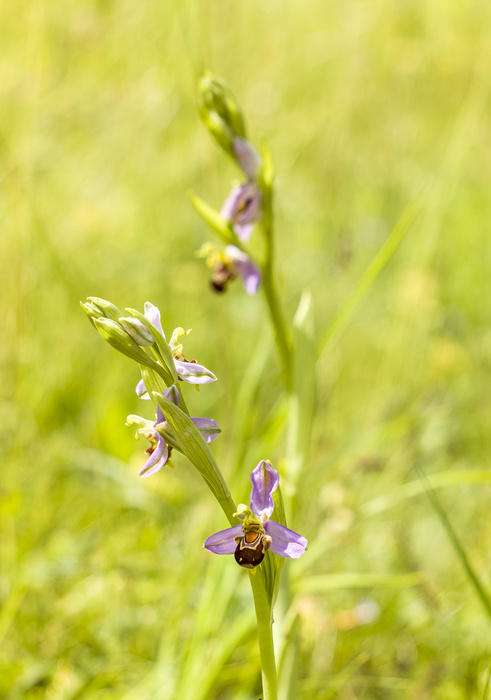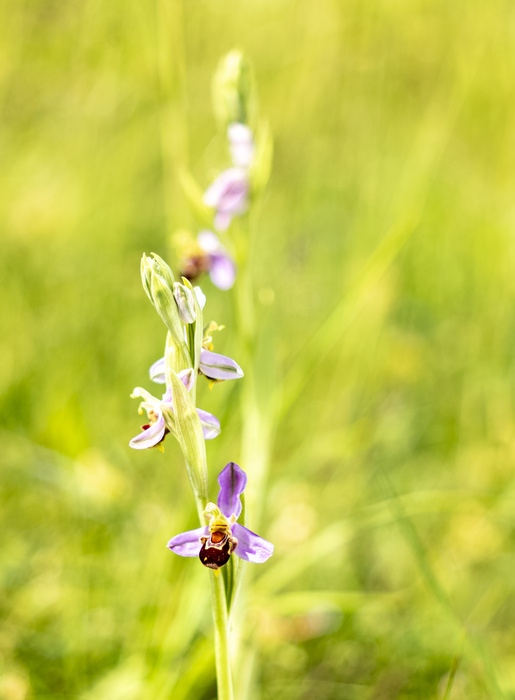Keith Walker's Close Ups With a Leica M
29th November 2024
In: News, Members' Articles
Keith shows us the results of his work with a digital Leica M with a CMOS Sensor and the traditional bellows.
A Bit of Fun With A Leica M
by
Keith Walker
Some close friends of ours, who obviously know of my interest in photography, had discovered some self seeded Bee Orchids on a bank in their garden and my friend asked me to ‘do her a print’ of them. Guess we have all been there!
I had never heard of Bee Orchids, but they are well named as they are about the size of a bee. However, it was easy to see why the question was asked as they are beautiful to us as well as bees. Bee orchids mimic the shape and scent of female bees in order to lure the males to mate with the flower.
While the bee gets nothing but a wasted effort, the orchid transfers some of its pollen to the bee. When the bee flies off and lands on another orchid it deposits the pollen, allowing the flowers to reproduce.
The orchid has evolved to attract a particular type of bee. It has the appearance and smell of a female longhorn bee but in Britain, since this bee is rare, the orchid self-pollinates. Another example of Nature evolving.
As these days, for better or worse, I am only using M bodies I had to deploy another way of focussing the camera rather than the rangefinder. With the film cameras or with the M8 / M9, it was necessary to call on the traditional M way forward. This would have been to get out the (original) Visoflex, some bellows and the Visoflex Elmar 3.5/65mm and its mount.
Rather than use the Visoflex Prism, as I was using a digital M with a CMOS sensor I figured it would be easier, and more accurate for focusing, to use the electronic Visoflex that fits in the cameras hot shoe. Well it worked, and the lenses image quality was sufficient for a A3 print. Attached images show the garden, the set-up, and the stunning Bee Orchids.
Keith Walker – Copyright November 2024

Keith Walker - Leica M Close Ups

Keith Walker - Bee Orchids

Keith Walker - Bee Orchids
A Bit of Fun With A Leica M
by
Keith Walker
Some close friends of ours, who obviously know of my interest in photography, had discovered some self seeded Bee Orchids on a bank in their garden and my friend asked me to ‘do her a print’ of them. Guess we have all been there!
I had never heard of Bee Orchids, but they are well named as they are about the size of a bee. However, it was easy to see why the question was asked as they are beautiful to us as well as bees. Bee orchids mimic the shape and scent of female bees in order to lure the males to mate with the flower.
While the bee gets nothing but a wasted effort, the orchid transfers some of its pollen to the bee. When the bee flies off and lands on another orchid it deposits the pollen, allowing the flowers to reproduce.
The orchid has evolved to attract a particular type of bee. It has the appearance and smell of a female longhorn bee but in Britain, since this bee is rare, the orchid self-pollinates. Another example of Nature evolving.
As these days, for better or worse, I am only using M bodies I had to deploy another way of focussing the camera rather than the rangefinder. With the film cameras or with the M8 / M9, it was necessary to call on the traditional M way forward. This would have been to get out the (original) Visoflex, some bellows and the Visoflex Elmar 3.5/65mm and its mount.
Rather than use the Visoflex Prism, as I was using a digital M with a CMOS sensor I figured it would be easier, and more accurate for focusing, to use the electronic Visoflex that fits in the cameras hot shoe. Well it worked, and the lenses image quality was sufficient for a A3 print. Attached images show the garden, the set-up, and the stunning Bee Orchids.
Keith Walker – Copyright November 2024

Keith Walker - Leica M Close Ups

Keith Walker - Bee Orchids

Keith Walker - Bee Orchids
Comments
 By Ken Davis: Thanks for this short lesson in how our CMOS equipped M series are now capable of covering subjects that we normally dismiss as impossible with a rangefinder. The lens mount also allows us to mount lenses from other manufacturers. I've experimented successfully with Carl Zeiss & Meyer lenses and Nikon lenses. I've got an adapter for Contarex lenses that focus close so I'll experiment with that too.
By Ken Davis: Thanks for this short lesson in how our CMOS equipped M series are now capable of covering subjects that we normally dismiss as impossible with a rangefinder. The lens mount also allows us to mount lenses from other manufacturers. I've experimented successfully with Carl Zeiss & Meyer lenses and Nikon lenses. I've got an adapter for Contarex lenses that focus close so I'll experiment with that too. By David Askham: Keith, please accept full marks from me, for your decision to work with the photographic kit that you already possess. No lusting for something better endowed for the job, as the marketing people would have us believe. But back to yoour subject. It is amazing how wild orchids suddenly appear when ground is left to nature's grand plan.
By David Askham: Keith, please accept full marks from me, for your decision to work with the photographic kit that you already possess. No lusting for something better endowed for the job, as the marketing people would have us believe. But back to yoour subject. It is amazing how wild orchids suddenly appear when ground is left to nature's grand plan.